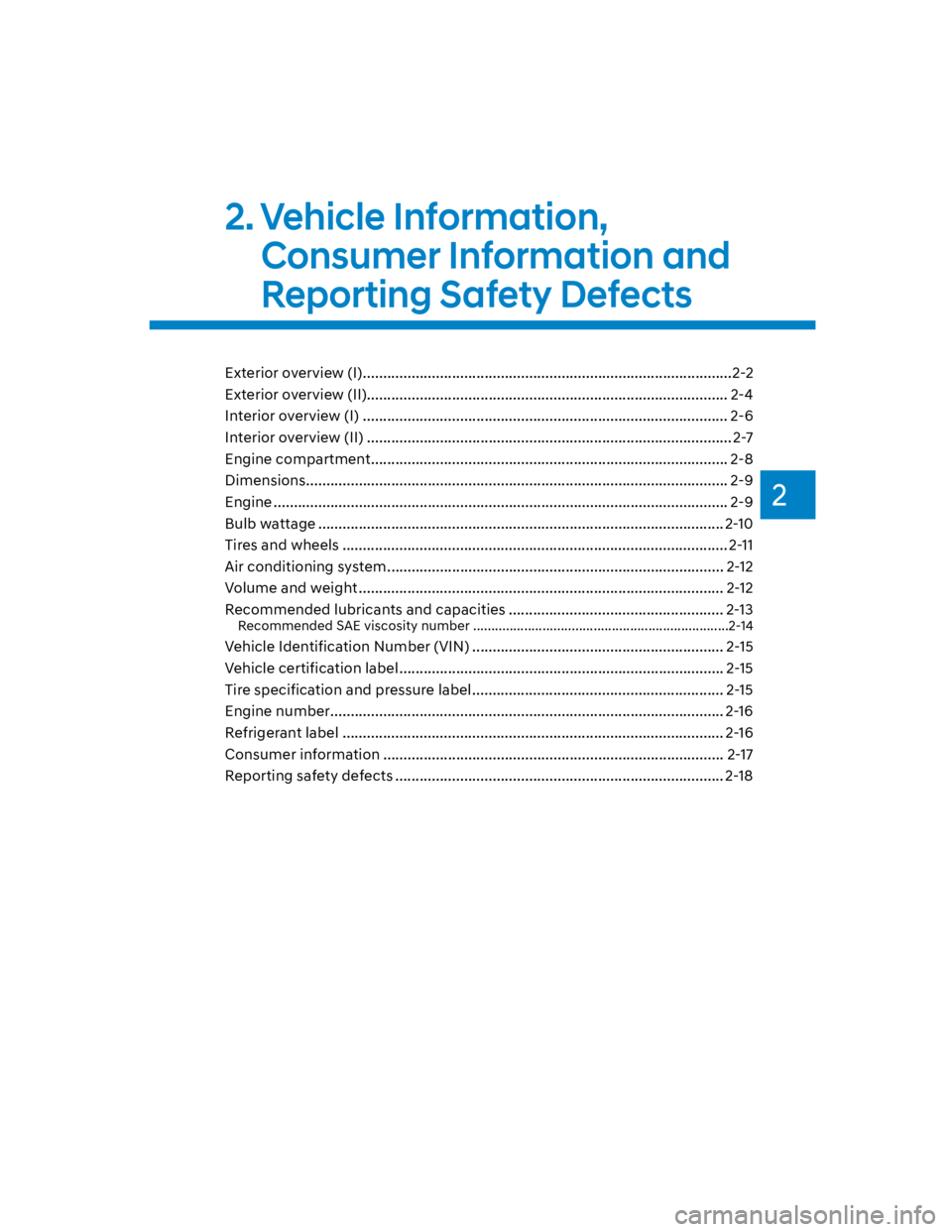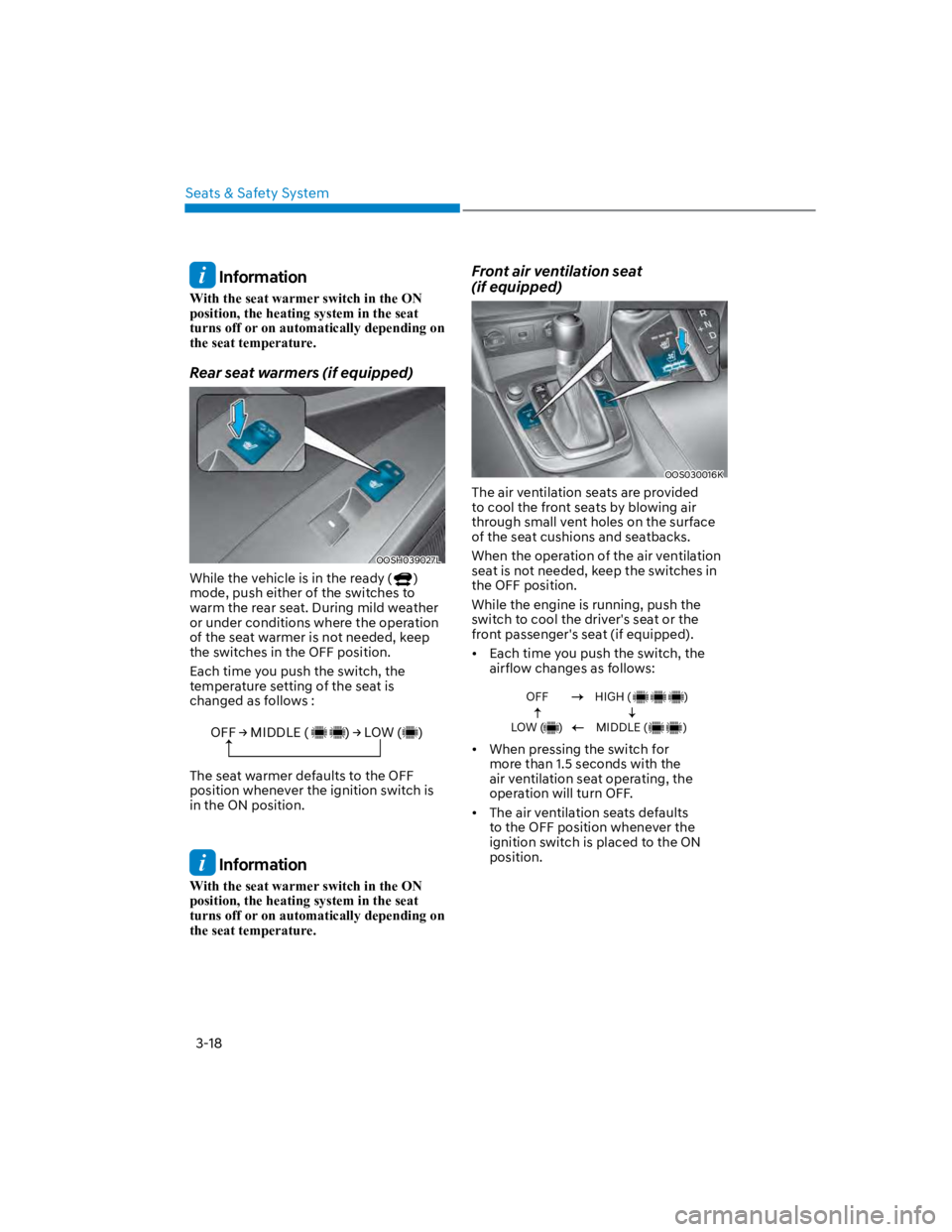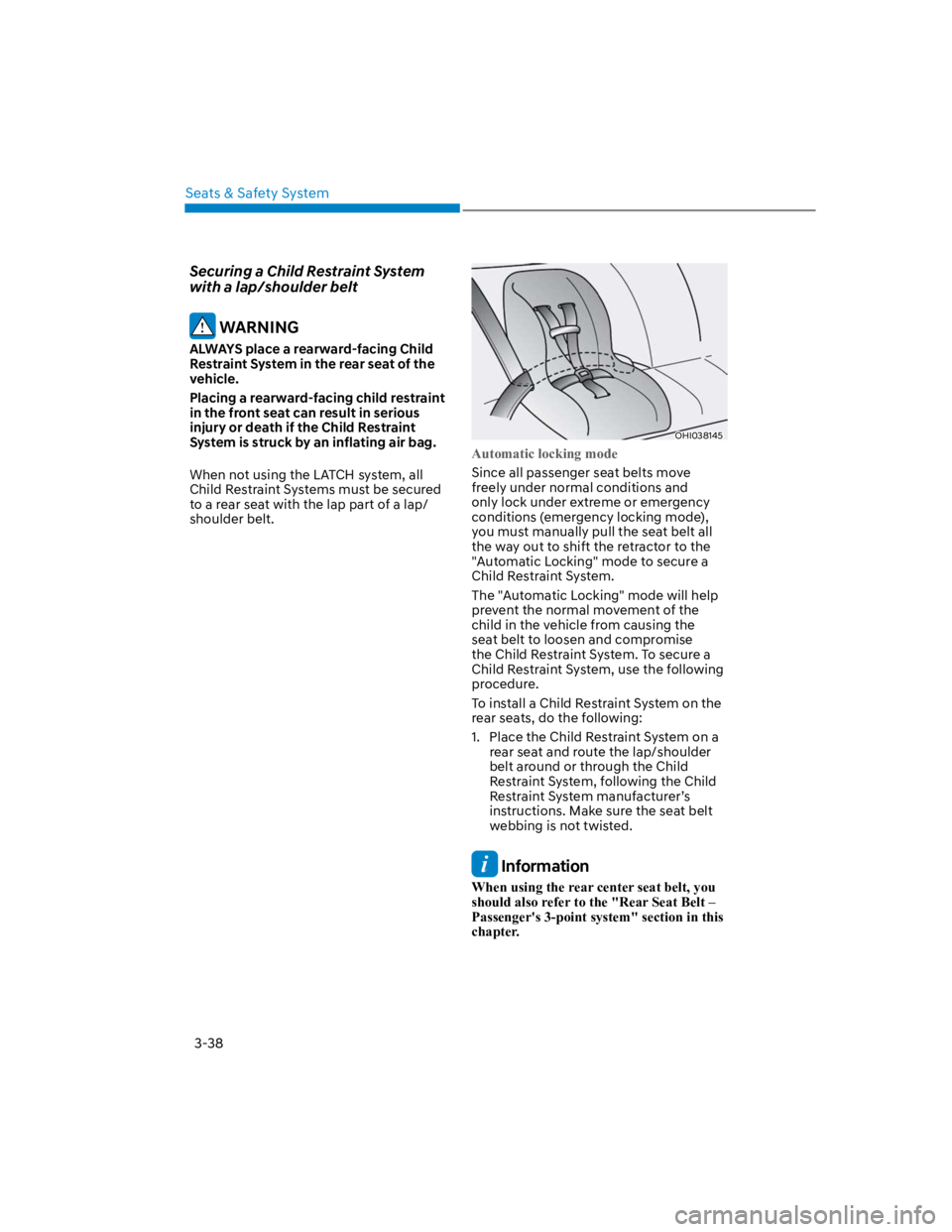2022 HYUNDAI KONA air condition
[x] Cancel search: air conditionPage 13 of 579

Foreword
1-8
This vehicle is equipped with an event data recorder (EDR). The main purpose of
an EDR is to record, in certain crash or near crash-like situations, such as an air bag
deployment or hitting a road obstacle, data that will assist in understanding how a
vehicle’s systems performed. The EDR is designed to record data related to vehicle
dynamics and safety systems for a short period of time, typically 30 seconds or less.
The EDR in this vehicle is designed to record such data as:
How various systems in your vehicle were operating;
Whether or not the driver and passenger safety belts were buckled/fastened;
How far (if at all) the driver was depressing the accelerator and/or brake pedal; and,
How fast the vehicle was traveling.
These data can help provide a better understanding of the circumstances in which
crashes and injuries occur. NOTE: EDR data are recorded by your vehicle only if a
non-trivial crash situation occurs; no data are recorded by the EDR under normal
driving conditions and no personal data (e.g., name, gender, age, and crash location)
are recorded. However, other parties, such as law enforcement, could combine the
EDR data with the type of personally identifying data routinely acquired during a crash
investigation.
To read data recorded by an EDR, special equipment is required, and access to the
vehicle or the EDR is needed. In addition to the vehicle manufacturer, other parties,
such as law enforcement, that have the special equipment, can read the information if
they have access to the vehicle or the EDR.
VEHICLE DATA COLLECTION AND EVENT DATA RECORDERS
Page 14 of 579

2
2. Vehicle Information,
Consumer Information and
Reporting Safety Defects
Exterior overview (I) ...........................................................................................2-2
Exterior overview (II) ......................................................................................... 2-4
Interior overview (I) .......................................................................................... 2-6
Interior overview (II) .......................................................................................... 2-7
Engine compartment ........................................................................................ 2-8
Dimensions ........................................................................................................ 2-9
Engine ................................................................................................................ 2-9
Bulb wattage .................................................................................................... 2-10
Tires and wheels ............................................................................................... 2-11
Air conditioning system ................................................................................... 2-12
Volume and weight .......................................................................................... 2-12
Recommended lubricants and capacities ..................................................... 2-13
Recommended SAE viscosity number ......................................................................2-14
Vehicle Identification Number (VIN) .............................................................. 2-15
Vehicle certification label ................................................................................ 2-15
Tire specification and pressure label .............................................................. 2-15
Engine number ................................................................................................. 2-16
Refrigerant label .............................................................................................. 2-16
Consumer information .................................................................................... 2-17
Reporting safety defects ................................................................................. 2-18
Page 25 of 579

Vehicle Information, Consumer Information and Reporting Safety Defects
2-12
Items Weight of volume Classification
Refrigerant
oz. (g)15.87 (450) ± 0.88 (25) R-1234yf
Compressor lubricant
oz. (g)4.23 (120) ± 0.35 (10) PAG
Contact an authorized HYUNDAI dealer for more details.
VOLUME AND WEIGHT
Items
Smartstream G 1.6T-GDi Smartstream G2.0 Atkinson
2WD 4WD 2WD 4WD
DCT DCT IVT IVT
Gross vehicle weight
lbs. (kg)
4,090 (1,855) 4,222 (1,915) 3,968 (1,800) 4,134 (1,875)
Luggage volume (VDA) MIN : 12.75 (361)
MAX : 40.36 (1,143)
DCT : Dual clutch transmission
IVT : Intelligent variable transmission
MIN : Behind rear seat to upper edge of the seat back.
MAX : Behind front seat to roof.
AIR CONDITIONING SYSTEM
Page 32 of 579

3
3. Seats & Safety System
Important safety precautions ...........................................................................3-2
Always wear your seat belt .......................................................................................... 3-2
Restrain all children ...................................................................................................... 3-2
Air bag hazards ............................................................................................................. 3-2
Driver distraction .......................................................................................................... 3-2
Control your speed ....................................................................................................... 3-2
Keep your vehicle in safe condition ............................................................................ 3-2
Seats .................................................................................................................. 3-3
Safety precautions .......................................................................................................3-4
Front seats ....................................................................................................................3-5
Rear Seats ................................................................................................................... 3-10
Head Restraints ...........................................................................................................3-13
Seat Warmers and Air Ventilation Seats ....................................................................3-17
Seat belts ......................................................................................................... 3-20
Seat belt safety precautions ......................................................................................3-20
Seat belt warning light ................................................................................................3-21
Seat belt restraint system .......................................................................................... 3-22
Additional seat belt safety precautions .................................................................... 3-27
Care of seat belts........................................................................................................ 3-29
Child Restraint System (CRS) ......................................................................... 3-30
Children Always in the Rear .......................................................................................3-30
Selecting a Child Restraint System (CRS) ..................................................................3-31
Installing a Child Restraint System (CRS) ................................................................. 3-33
Air bag - supplemental restraint system ........................................................ 3-41
Where are the air bags? .............................................................................................3-43
How does the air bags system operate? .................................................................. 3-46
What to expect after an air bag inflates .................................................................. 3-49
Occupant Classification System (OCS) .................................................................... 3-50
Why didn’t my air bag go off in a collision? ..............................................................3-56
SRS care ...................................................................................................................... 3-61
Additional safety precautions....................................................................................3-62
Air bag warning labels................................................................................................3-62
This chapter provides you with important information about how to protect yourself and your
passengers. It explains how to properly use your seats and seat belts, and how your air bags work.
Additionally, this chapter explains how to properly restrain infants and children in your vehicle.
Page 33 of 579

Seats & Safety System
3-2
You will find many safety precautions
and recommendations throughout this
section, and throughout this manual.
The safety precautions in this section are
among the most important.
Always wear your seat belt
A seat belt is your best protection in all
types of accidents. Air bags are designed
to supplement seat belts, not to replace
them. So even though your vehicle is
equipped with air bags, ALWAYS make
sure you and your passengers wear your
seat belts, and wear them properly.
Restrain all children
All children under age 13 should ride
in your vehicle properly restrained in a
rear seat, not the front seat. Infants and
small children should be restrained in
an appropriate Child Restraint System.
Larger children should use a booster
seat with the lap/shoulder belt until they
can use the seat belt properly without a
booster seat.
Air bag hazards
While air bags can save lives, they can
also cause serious or fatal injuries to
occupants who sit too close to them, or
who are not properly restrained. Infants,
young children, and short adults are at
the greatest risk of being injured by an
inflating air bag. Follow all instructions
and warnings in this manual.
Driver distraction
Driver distraction presents a serious and
potentially deadly danger, especially for
inexperienced drivers. Safety should be
the first concern when behind the wheel
and drivers need to be aware of the wide
array of potential distractions, such as
drowsiness, reaching for objects, eating,
personal grooming, other passengers,
and using mobile phones.
Drivers can become distracted when
they take their eyes and attention off
the road or their hands off the wheel to
focus on activities other than driving.
To reduce your risk of distraction and an
accident:
Set up your mobile devices (i.e., MP3
players, phones, navigation units, etc.)
ONLY when your vehicle is parked or
safely stopped.
ONLY use your mobile device when
allowed by laws and conditions permit
safe use. NEVER text or email while
driving. Most countries have laws
prohibiting drivers from texting. Some
countries and cities also prohibit
drivers from using handheld phones.
NEVER let the use of a mobile device
distract you from driving. You have a
responsibility to your passengers and
others on the road to always drive
safely, with your hands on the wheel
as well as your eyes and attention on
the road.
Control your speed
Excessive speed is a major factor in crash
injuries and deaths. Generally, the higher
the speed, the greater the risk, but
serious injuries can also occur at lower
speeds. Never drive faster than is safe
for current conditions, regardless of the
maximum speed posted.
Keep your vehicle in safe
condition
Having a tire blowout or a mechanical
failure can be extremely hazardous. To
reduce the possibility of such problems,
check your tire pressures and condition
frequently, and perform all regularly
scheduled maintenance.
IMPORTANT SAFETY PRECAUTIONS
Page 48 of 579

03
3-17
Seat Warmers and Air Ventilation
Seats
Front seat warmers (if equipped)
Seat warmers are provided to warm the
seats during cold weather.
WARNING
The seat warmers can cause a SERIOUS
BURN, even at low temperatures and
especially if used for long periods of
time.
Passengers must be able to feel if the
seat is becoming too warm so they can
turn it off, if needed.
People who cannot detect temperature
change or pain to the skin should
use extreme caution, especially the
following types of passengers:
Infants, children, elderly or disabled
persons, or hospital outpatients.
People with sensitive skin or who
burn easily.
Fatigued individuals.
Intoxicated individuals.
People taking medication that can
cause drowsiness or sleepiness.
Individuals with medical condition
affecting their ability to detect
temperature change
WARNING
NEVER place anything on the seat
that insulates against heat when the
seat warmer is in operation, such as a
blanket or seat cushion. This may cause
the seat warmer to overheat, causing a
burn or damage to the seat.
NOTICE
To prevent damage to the seat warmers
and seats:
Never use a solvent such as paint
thinner, benzene, alcohol or gasoline
to clean the seats.
Do not place heavy or sharp objects
on seats equipped with seat
warmers.
Do not change the seat cover. It may
damage the seat warmer.
Front seat
OOS030015K
[A] : Type A, [B] : Type B
While the engine is running, push either
of the switches to warm the driver's seat
or front passenger's seat.
During mild weather or under conditions
where the operation of the seat warmer
is not needed, keep the switches in the
OFF position.
Each time you push the switch, the
temperature setting of the seat is
changed as follows:
OFF
LOW ( )
HIGH ( )
MIDDLE ( )
When pressing the switch for more
than 1.5 seconds with the seat warmer
operating, the seat warmer will turn
OFF.
The seat warmer defaults to the OFF
position whenever the ignition switch
is ON.
Page 49 of 579

Seats & Safety System
3-18
Information
With the seat warmer switch in the ON
position, the heating system in the seat
turns off or on automatically depending on
the seat temperature.
Rear seat warmers (if equipped)
OOSH039027L
While the vehicle is in the ready ()
mode, push either of the switches to
warm the rear seat. During mild weather
or under conditions where the operation
of the seat warmer is not needed, keep
the switches in the OFF position.
Each time you push the switch, the
temperature setting of the seat is
changed as follows :
OFF MIDDLE ( ) LOW ( )
The seat warmer defaults to the OFF
position whenever the ignition switch is
in the ON position.
Information
With the seat warmer switch in the ON
position, the heating system in the seat
turns off or on automatically depending on
the seat temperature.
Front air ventilation seat
(if equipped)
OOS030016K
The air ventilation seats are provided
to cool the front seats by blowing air
through small vent holes on the surface
of the seat cushions and seatbacks.
When the operation of the air ventilation
seat is not needed, keep the switches in
the OFF position.
While the engine is running, push the
switch to cool the driver's seat or the
front passenger's seat (if equipped).
Each time you push the switch, the
airflow changes as follows:
OFF
LOW ( )
HIGH ( )
MIDDLE ( )
When pressing the switch for
more than 1.5 seconds with the
air ventilation seat operating, the
operation will turn OFF.
The air ventilation seats defaults
to the OFF position whenever the
ignition switch is placed to the ON
position.
Page 69 of 579

Seats & Safety System
3-38
Securing a Child Restraint System
with a lap/shoulder belt
WARNING
ALWAYS place a rearward-facing Child
Restraint System in the rear seat of the
vehicle.
Placing a rearward-facing child restraint
in the front seat can result in serious
injury or death if the Child Restraint
System is struck by an inflating air bag.
When not using the LATCH system, all
Child Restraint Systems must be secured
to a rear seat with the lap part of a lap/
shoulder belt.
OHI038145
Automatic locking mode
Since all passenger seat belts move
freely under normal conditions and
only lock under extreme or emergency
conditions (emergency locking mode),
you must manually pull the seat belt all
the way out to shift the retractor to the
"Automatic Locking" mode to secure a
Child Restraint System.
The "Automatic Locking" mode will help
prevent the normal movement of the
child in the vehicle from causing the
seat belt to loosen and compromise
the Child Restraint System. To secure a
Child Restraint System, use the following
procedure.
To install a Child Restraint System on the
rear seats, do the following:
1. Place the Child Restraint System on a
rear seat and route the lap/shoulder
belt around or through the Child
Restraint System, following the Child
Restraint System manufacturer’s
instructions. Make sure the seat belt
webbing is not twisted.
Information
When using the rear center seat belt, you
should also refer to the "Rear Seat Belt –
Passenger's 3-point system" section in this
chapter.